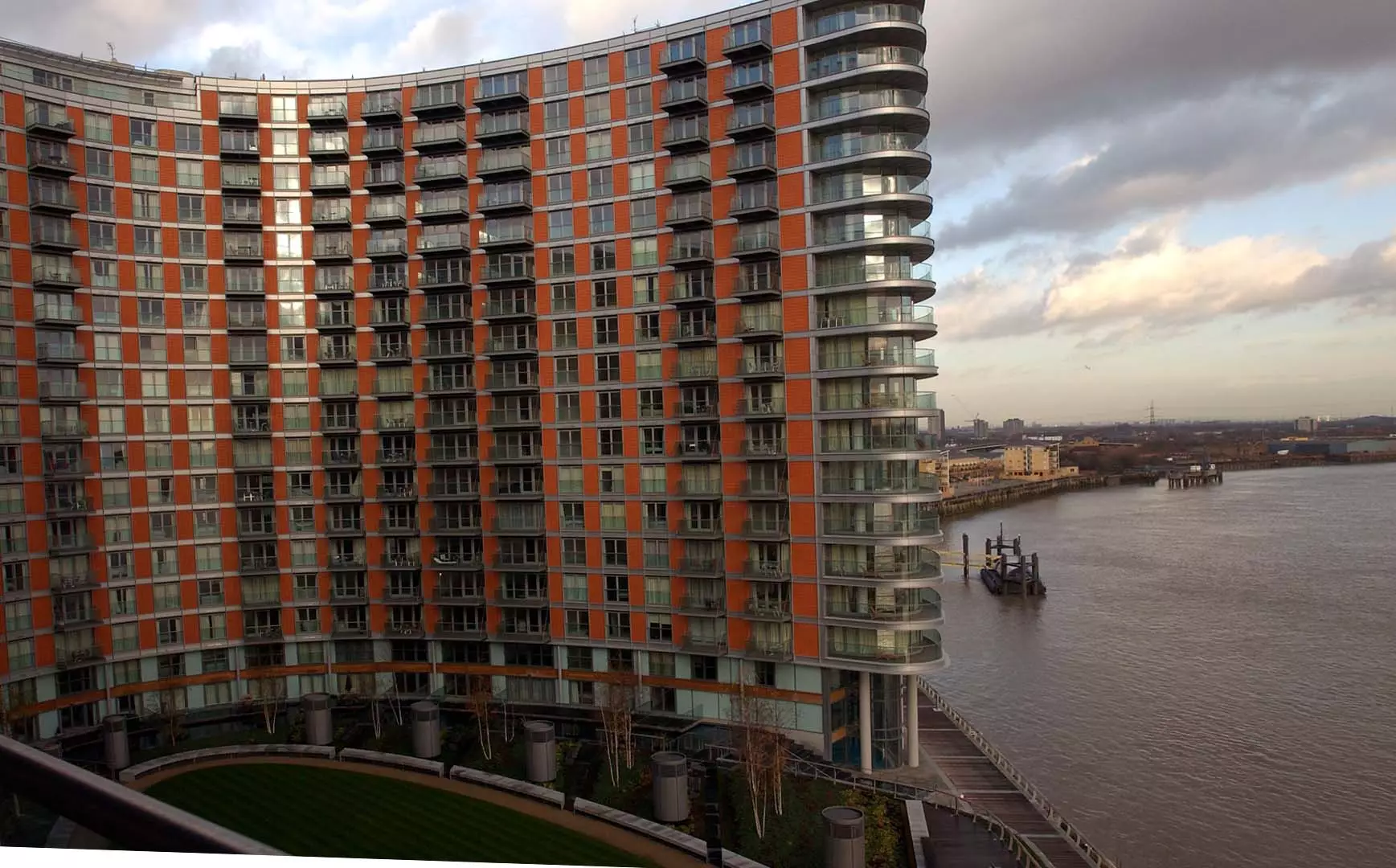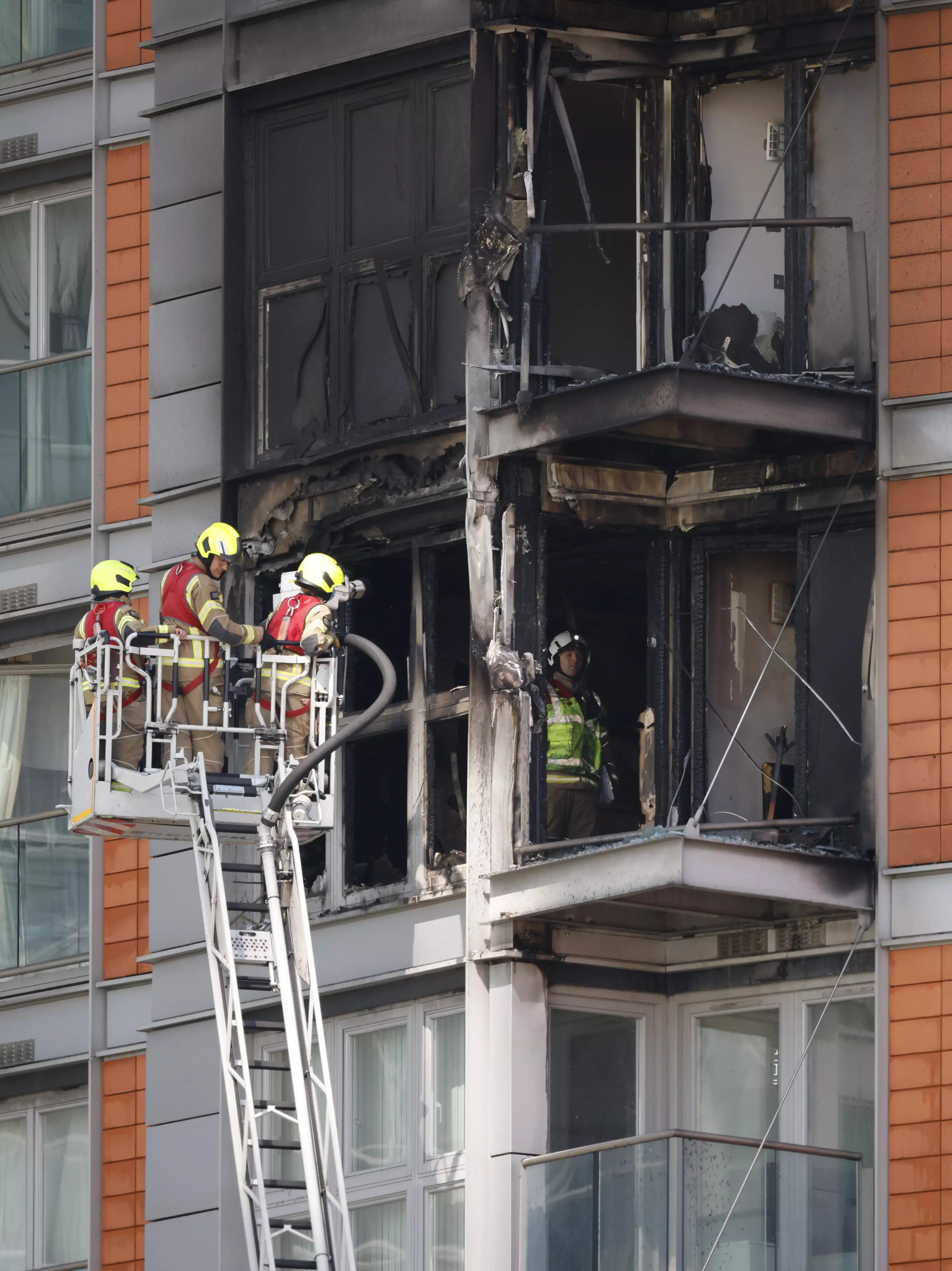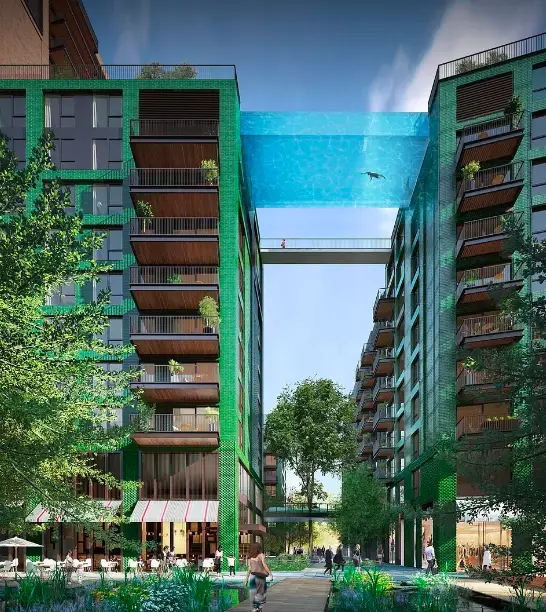
You'd have to have been living under a rock to have missed the jaw-dropping images of the Nine Elms sky pool, which made international headlines when it opened last month.
The pool, suspended between two skyscrapers in London's Embassy Gardens, welcomed its first visitors as a scorching heatwave hit the capital, with some 20 million people watching a video of the attraction online.
Dubbed a feat of innovation from the Irish building developers Ballymore, the towering acrylic structure was the first of its kind - a fish tank full of well-to-do bathers flaunting their tanned torsos to the envious passersby below.
Advert
However, just across the river, Natalie Carter lives in New Providence Wharf - another Ballymore developed property with a far less glowing backstory.
The 17-year-old building in Poplar, east London, set on fire in May, and homeowner Natalie, 43, says that after a three-and-a-half year battle with the company over their reluctance to fund the removal of Grenfell-style cladding on her building, the sky pool's theatrical unveiling has been a rather bitter pill to swallow.
Programme manager Natalie tells Tyla she was "furious" when she saw the time and money that was funnelled into the sky pool; while she's been plagued with sleepless nights since she first found out her building was covered in aluminium composite material (ACM) - the same cladding that fuelled the 2017 Grenfell blaze and resulted in the deaths of 72 people.
Advert
"It was some time in the aftermath of Grenfell that we first found out [about the dangerous cladding]," she recalls. "At that point obviously all of us were terrified to be in the building and pressing for Ballymore to come back with a solution."

But the battle to have the cladding removed raged on for almost four years, with preliminary work only beginning last month.
Natalie says that Ballymore - who made a profit of £97m in 2020 - offered just £500,000 towards the £11.6m cost of removing cladding on New Providence Wharf; even with a government grant, leaseholders were left with with the prospect of funding £3.1 million themselves.
Advert
Then came the fire, on the morning of Monday 7th May. The blaze took place in block D of the 19-storey building, spreading from the eighth floor up to the 11th floor externally.

More than 120 London Fire officers had to rescue 34 people from the building, and two people were treated in hospital as a result of burns and smoke inhalation.
Natalie was in the building at the time, but only found out about the fire thanks to a series of frantic WhatsApp messages.
Advert
She says the fire highlighted a series of serious safety concerns, including a lack of audible alarms or sprinklers in her block; a fault with the smoke ventilation system; and timber decking on the balconies which worsened the spread of the blaze.
"If it were to happen again, which of course it could, and if it were to happen in the night, people would just die, there's no two ways about it,' she says.

To make matters worse, Natalie and the other leaseholders at New Providence Wharf are now expected to foot the bill for some of the other issues the fire brigade uncovered - such as ill-fitted fire doors - all while paying ever increasing service charges and funding 24 hour fire safety patrols, which she expects to cost her around £10,000 this year alone.
Advert
Unfortunately, any hopes of escaping the lease and moving elsewhere amid the increased costs are out of the question, as the flat is un-mortgageable until the cladding is gone.
While the London Fire Brigade said that cladding was likely not the cause of the fire, a parliamentary report found that cladding on the eighth and ninth floors was "involved" in the spread of the blaze.
In the aftermath of the fire, despite admitting no wrongdoing, Ballymore did a u-turn and promised to cover the cost of cladding removal (and any additional remediation work) at New Providence Wharf.

Speaking to Tyla, Dominic Buxton from the End Our Cladding Scandal group said: "The most recent fires at New Providence Wharf were terrifying and once again highlighted the cataclysmic failures of government and developers like Ballymore to get a handle on solving the fire safety scandal and ensure the safety of residents.
"Ballymore spent an extortionate amount of money installing an 82ft sky pool at Embassy Gardens. This is nothing but a slap in the face to leaseholders who are left trapped and unsafe in New Providence Wharf and other properties, which are now practically worthless.
"Let's not make any mistake about it [...] if the government and Ballymore wanted to solve this crisis, they could and they would. It's not a question of 'can they?', it's a question of 'will they?'
"Right now, unfortunately it is just a matter of time before a Grenfell-scale disaster happens again."
When approached by Tyla, Ballymore said in a statement: "Ballymore has contractors onsite at New Providence Wharf removing ACM from the building. This work began prior to the 7th May incident and will be finished as a matter of urgency. It will be funded by the government and by Ballymore, which built the property 17 years ago in full accordance with regulations.
"Ballymore has set aside £20 million for remediation of properties in London following changes in building regulations. This is an industry-wide issue and our financial contribution is among the largest relative to our size.

"All necessary works to repair damage caused by the fire are underway and will be completed as quickly as possible, at no cost to leaseholders.
"Ballymore recently commissioned SAY Property to conduct an independent third-party review of services charges across our London estate. It found that Ballymore service charges are competitive, represent good value for money and are, in the vast majority of schemes, 'in line with or better than market comparables'.
"We manage our estates entirely in the interests of leaseholders and not with a view to profit. We will continue to do everything to keep charges as low as possible while providing the services our residents expect."
Today, Natalie says that she still can't shake the distrust she feels towards the company, after everything that has happened, and adds that Ballymore shouldn't be focusing on flashy new projects, like the sky pool, until they have sorted all existing issues within their older buildings.
"I feel much more anxious since the fire," she says. "We were ignorant before, we knew there was dangerous cladding, but we didn't realise the extent of all the other issues.
"The system completely failed. We know the building is a tinderbox waiting to go. Home is supposed to be your safe space, where you go after a stressful day at work, but it's more stressful here than everywhere else".
"If they had made more an effort sooner it wouldn't have got to this."
Inside the New Providence Wharf fire
The London Fire Brigade is still investigating possible breaches of fire safety regulations at New Providence Wharf, but initial reports show some serious failures.
What they know so far is that the fire begun in the fuse board of an 8th floor flat in block D - around 25 metres from Natalie's flat.
Here are some of the issues they uncovered:
- "During the incident, fire safety systems that should have supported both the safety of residents and
firefighting operations did not perform as expected. This included the Automatic Opening Vents,
cross corridor door holders, the Automatic Fire Detection (AFD) system and the
Firefighters lift."
- "A serious failure of a smoke ventilation system that resulted in the building acting like a broken chimney left residents' only escape route smoke logged."
- Smoke filled corridors "increasing the challenges and risks for firefighting and search and rescue operations within the building."
- "The spread of fire on the outside of the building from floors 8 to 11 is believed to have been facilitated by timber decking on the balconies".
The London Fire Brigade Deputy Commissioner Richard Mills said: "The New Providence Wharf fire needs to be an urgent wake-up call to all building owners and managers.
"Look at the fire safety solutions inside your building and take action if they are not performing correctly. It is too late to wait for a fire to see if they work."
Featured Image Credit: Shutterstock